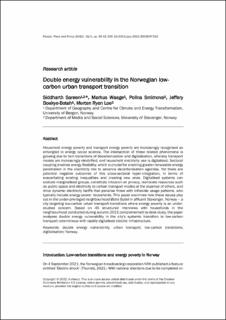| dc.contributor.author | Sareen, Siddharth | |
| dc.contributor.author | Waage, Markus | |
| dc.contributor.author | Smirnova, Polina | |
| dc.contributor.author | Boakye Botah, Jeffery | |
| dc.contributor.author | Loe, Morten Ryen | |
| dc.date.accessioned | 2023-02-16T14:45:46Z | |
| dc.date.available | 2023-02-16T14:45:46Z | |
| dc.date.created | 2023-01-31T08:52:23Z | |
| dc.date.issued | 2022 | |
| dc.identifier.issn | 1753-8041 | |
| dc.identifier.uri | https://hdl.handle.net/11250/3051636 | |
| dc.description.abstract | Household energy poverty and transport energy poverty are increasingly recognised as entangled in energy social science. The intersection of these related phenomena is growing due to twin transitions of decarbonisation and digitalisation, whereby transport modes are increasingly electrified, and household electricity use is digitalised. Sectoral coupling enables energy flexibility, which is crucial for enabling greater renewable energy penetration in the electricity mix to advance decarbonisation agendas. Yet there are potential negative outcomes of this cross-sectoral hyper-integration, in terms of exacerbating existing inequalities and creating new ones. Digitalised systems can exclude marginalised groups, constitute intrusion on privacy, reallocate resources such as public space and electricity to certain transport modes at the expense of others, and drive dynamic electricity tariffs that penalise those with inflexible usage patterns, who typically include energy-poorer households. This paper examines how these issues play out in the under-privileged neighbourhood Østre Bydel in affluent Stavanger, Norway – a city targeting low-carbon urban transport transitions where energy poverty is an under-studied concern. Based on 45 structured interviews with households in the neighbourhood conducted during autumn 2021 complemented by desk study, the paper analyses double energy vulnerability in the city’s systemic transition to low-carbon transport coterminous with rapidly digitalised electric infrastructure. | en_US |
| dc.language.iso | eng | en_US |
| dc.publisher | Sheffield Hallam University | en_US |
| dc.rights | Navngivelse 4.0 Internasjonal | * |
| dc.rights.uri | http://creativecommons.org/licenses/by/4.0/deed.no | * |
| dc.title | Double energy vulnerability in the Norwegian low-carbon urban transport transition | en_US |
| dc.type | Journal article | en_US |
| dc.description.version | publishedVersion | en_US |
| dc.rights.holder | Copyright 2022 the authors | en_US |
| cristin.ispublished | true | |
| cristin.fulltext | original | |
| dc.identifier.doi | 10.3351/ppp.2022.3953567323 | |
| dc.identifier.cristin | 2119313 | |
| dc.source.journal | People, Place and Policy | en_US |
| dc.source.pagenumber | 33-52 | en_US |
| dc.identifier.citation | People, Place and Policy. 2022, 16 (1), 33-52. | en_US |
| dc.source.volume | 16 | en_US |
| dc.source.issue | 1 | en_US |

